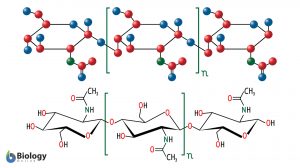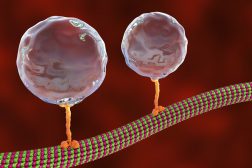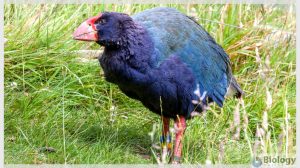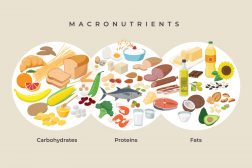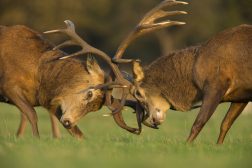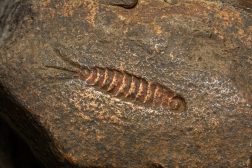
ˈkaɪ tɪn
Table of Contents
Definition
noun
plural: chitin
chi·tin, ˈkaɪtɪn
(1) A polymer of nitrogen-containing polysaccharide (C8H13O5N)n rendering a tough, protective covering or structural support in certain organisms
(2) A polysaccharide which makes up the cell walls of fungi and exoskeleton of insects
Details
Overview
Chitin belongs to a group of polysaccharide carbohydrates. Carbohydrates are organic compounds comprised of carbon, hydrogen, and oxygen, usually in the ratio of 1:2:1. They are one of the major classes of biomolecules. Polysaccharide are carbohydrates made up of multiple saccharide units. Some of them serve as energy fuel whereas others have structural functions.
History and terminology
The discovery of chitin was credited to the French scientist Henri Braconnot in 1811. He was the first to describe the compound that he extracted from mushrooms and is insoluble in sulfuric acid. He named it fungine. Another French scientist, Auguste Odier was also able to isolate the compound from beetle cuticles and called it chitine, which was a French word derived from the Greek word χιτών (“chiton”), meaning covering. Later, the name of the compound was changed to chitin.1 Since then, chitin has been uses in medicine and industry. It has several applications since it is nontoxic, biodegradable (thus, more environmental friendly), and has antimicrobial properties. For instance, it has been used in surgical stitches that dissolve over time. It has also been used as an additive in certain creams and cosmetics.1 The structure of chitin was made known in 1929 by the Swiss scientist Albert Hofmann 1906 –2008 (who was more popularly identified as the discoverer of lysergic acid diethylamide, LSD) .
Structure
Chitin resembles keratin (protein component in human hair and nails) in structural function. Nonetheless, it differs from keratin through its carbohydrate (polysaccharide) structural component. In terms of structure, it resembles cellulose. Chitin is a modified carbohydrate for containing nitrogen. It is made up of a linear polymer of N-acetyl-D-glucosamine monomers (C8H13O5N) n»1. Similar to cellulose, the monomers are linked to each other by β(1→4) glycosidic bond. In cellulose though, the monomers are glucose units. Furthermore, chitin has an acetylamine group instead of a hydroxyl group on each monomer. This enables more opportunities of hydrogen bonding between polymers in chitin, and thereby renders increased structural strength. Removal of the acetyl COCH3 groups from chitin results in the formation of chitosan, which unlike chitin, is soluble in water.
Types
There are three major crystalline forms of chitin described:2
- α-chitin. It is the most predominant form of chitin. It occurs as microfibrils arranged in antiparallel manner. It is less soluble in water, with strong mechanical properties. The low water solubility is due to the presence of intra-chain hydrogen bonds. It occurs in arthropods, including insects. In crustaceans, it is heavily mineralized with calcium and magnesium salts.
- β-chitin. This form of chitin occurs as microfibrils arranged in parallel orientation. It can be hydrated rather easily than α-chitin. It is also highly flexible. It is found in squid pens and diatom spines.
- γ-chitin. This form of chitin consists of β-chitin and α-chitin. It is found in the cocoons of certain beetles.
Common biological reactions
Chitin is considered as the second most abundant natural polysaccharide. It occurs in the exoskeleton of certain insects and crustaceans. It is also a component of the cell wall in certain fungi. Other organisms that synthesize chitin are certain protists, sponges, coelenterates, nematodes, mollusks, and Rhizobia. In insects, chitin is synthesized chiefly in the epidermis and the midgut. Chitin precursors may be trehalose and glycogen.3 Below is the chitin biosynthetic pathway where trehalose is the initial substrate, as proposed by Kramer and Koga, 19864 and Cohen, 20015:
(1) trehalose → β-D-glucose (by trehalase)
(2) β-D-glucose → glucose-6-phosphate (by hexokinase)
(3) glucose-6-phosphate → fructose-6-phosphate (by ”glucose-6-phosphate isomerase)
(4) fructose-6-phosphate → glucosamine-6-phosphate (by ”glutamine:fructose-6-phosphate aminotransferase)
(5) glucosamine-6-phosphate → N-acetyl-glucosamine-6-phosphate (by glucosamine-6-phosphate N-acetyltransferase)
(6) N-acetyl-glucosamine-6-phosphate → N-acetylglucosamine-1-phosphate (by phosphoacetylglucosamine mutase)
(7) N-acetylglucosamine-1-phosphate → UDP-N-acetylglucosamine (by UDP-N-acetylglucosamine pyrophosphorylase)
(8) UDP-N-acetylglucosamine → chitin polymer (by chitin synthase)
Chitin is usually combined with other compounds (e.g. calcium carbonate), forming a stronger composite material; pure chitin or calcium carbonate alone would be brittle and not as tough as the composite.
Common biological reactions
In insects and crustaceans that undergo molting and metamorphosis, chitin degradation and synthesis occur simultaneously and in a coordinated manner. A binary enzyme system (comprised of chitinases and ~-N-acetylglucosaminidase) from the molting fluid degrades chitin in exoskeletons and gut linings into monomeric components, especially during molting. In particular, chitinases degrade chitin into oligosaccharides whereas ~-N-acetylglucosaminidase further degrades the oligosaccharides into N-acetyl-D-glucosamine monomers from the non-reducing end. 3 These enzymes catalyze the hydrolysis of β-(1-4)-glycosidic bond.
Biological importance
Chitin serves as a protective covering and mechanical support to soft-bodied organisms producing it. In insects and arthropods, chitin is a crucial component of their exoskeleton. Chitin is also present in insect body wall, gut lining, salivary glands, mouth parts, and muscle attachment points. In chitinous fungi, chitin is present rather than cellulose in their cell wall. Apart from insects, certain arachnids have also chitin in their hard outer covering. Chitin is also present in the radula of molluscs and the beaks of cephalopods. Humans and other vertebrates do not produce chitin. As such, enzymes that degrade chitin can be used as potential fungicides as well as insecticides that target chitinous fungi and disease-causing insects. Chitin and chitosan are used as food additive, thickener, texturizer, emulsifier, humectant, and stabilizer in confectionery, beverages, and other foods. Chitosan is regarded as generally safe by the U.S. Food and Drug Administration. However, individuals with allergies in crustaceans may need to avoid chitin- or chitosan-containing food. 6
Supplementary
Etymology
- Latin chitōn (meaning “mollusk”)
- French chitine, from the Greek word χιτών (“chiton”, meaning covering)
Derived term(s)
- Chitin synthase
- chitinous (adjective)
Further reading
See also
- polysaccharide
- carbohydrate
Mention(s)
- Carbohydrate
- Glycan
- Cell wall
- Fungus
Reference
- Stoye, E. (2019). Chitin. Retrieved from www.chemistryworld.com/podcasts/chitin/6478.article Link
- Muthukrishnan, S., Merzendorfer, H., Arakane, Y., & Yang, Q. (2016). Chapter 2: Chitin Metabolic Pathways in Insects and Their Regulation. In E. Cohen & B. Moussian (Eds.), Extracellular Composite Matrices in Arthropods (pp. 31-65). Switzerland: Springer International Publishing. doi:10.1007/978-3-319-40740-1-2
- Muthukrishnan, S. & Kramer, K. J. (2005). Chitin Metabolism in Insects. Elsevier. pp. 497 – 530. pdfs.semanticscholar.org/4639/2839937041824808771814408beb72cb50cb.pdf PDF
- Kramer, K. J. and Koga, D. (1986). Insect chitin: physical state, synthesis, degradation and metabolic regulation. Insect Biochem. 16,851 -877
- Cohen, E. (2001). Chitin synthesis and inhibition: a revisit. Pest Manag. Sci. 57,946 -950.
- Chitin and Chitosan – Nutrients Review. (2015, August 17). Retrieved from www.nutrientsreview.com/carbs/insoluble-fiber-chitin-chitosan.html Link
© Biology Online. Content provided and moderated by Biology Online Editors
